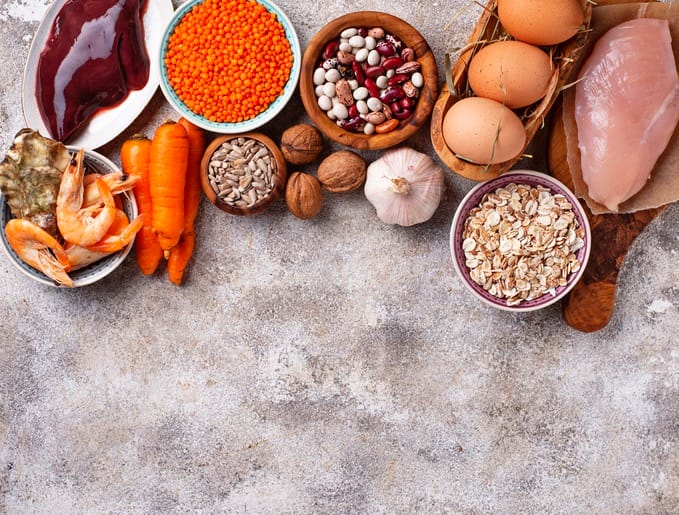Anaemia is known to be the most common nutritional deficiency, affecting an average of 1.62 billion people worldwide. Anaemia generally occurs when the body lacks a sufficient amount of red blood cells.
This lack of cells can be caused by excessive blood loss caused by serious injuries, menstruation, or haemorrhoids, but most commonly it is due to a lack of iron and other nutrients in the diet. If left untreated, iron-deficiency anaemia can lead to various health issues in the long-run. When your body does not produce enough functioning red blood cells, it lacks a significant amount of oxygen that is needed for the body. This both harms and damages organs, especially the heart.
Red blood cells contain haemoglobin, which is a protein rich in iron and is responsible for giving your blood its red colour. Without adequate iron, your body will not be able to produce enough haemoglobin for red blood cells.
The common symptoms of anaemia include tiredness, fatigue, dizziness, pale skin, shortness of breath during physical activity, increased heartbeat, headaches, brittle nails, and weak joints. Depending on the severity of the anaemia, other symptoms may include abdominal pain, unusual cravings for certain foods such as paper or chalk, sudden bleeding from the gums, nose, or anus, and cuts at the sides of the mouth.
Although these symptoms are rare, having iron-deficiency anaemia will usually make a person look extremely pale and tired. It is recommended to check with your doctor prior to making any further steps in order to ensure that your condition is thoroughly evaluated through the process of accurate blood tests.
Luckily, this type of anaemia can be easily treated by increasing your dietary iron intake, as well as introducing iron supplements to compensate for the missing iron in the body. Iron is predominantly found in red meat, beans, some dried fruit, and a variety of different vegetables.
Overcoming anaemia could be made easy by nourishing your body with the right foods in order to produce healthy sized red blood cells. We’ve listed some iron-rich foods below to help identify which specific foods support red blood cell production:
Green leafy vegetables such as spinach, kale, Swiss chard and rocket are all rich in non-haem iron and provide a wide variety of nutritional benefits along with essential vitamins and minerals
Red meats, such as beef liver, chicken liver, bison, lamb, etc. all contain haem iron, which is easily absorbed into the blood and is paired with vitamin B12 which also aids in iron absorption
Plant-based proteins such as beans and lentils provide a great source of non-haem-iron when combined with foods rich in vitamin C. Nuts and seeds are also extremely high in iron and offer a myriad of important vitamins and minerals.
Foods high in vitamin C (such as oranges and other citrus fruits, squash, pumpkin, red sweet peppers, tomatoes, cabbage, Brussels sprouts, and strawberries) can enhance the levels of non-haem iron in your body and increase the absorption of iron into your blood.
When paired with iron rich foods such as spinach, vitamin C helps with the absorption and metabolism of iron, especially with those of the plant-based varieties that require more help with absorption. It has been shown that only 5 to 20% of the iron found in plants (non-haem iron) travels through your digestive system to your blood; compared to the 10 to 25% of the iron found in animal-based foods (haem iron).
Beetroot is also an iron-rich vegetable that you can juice and drink to reduce extreme fatigue and headaches.
Vitamins D and B12 also play a significant role in treating anaemic patients, as they are both needed to produce an adequate number of red blood cells. Foods that contain B12 include meat, soy products and fortified foods. However, it is important to check your blood levels with your GP in order to find out which vitamins you are lacking.
Fortified cereals, grains (pasta, rice, bread) and plant-based milks (almond, soy, etc.) are all adequate sources of iron.
Milk and other dairy products may offer some minor qualities such as vitamin D and calcium, however dairy can make it harder for your body to absorb iron. Cow’s milk has also been shown to cause your intestines to lose small amounts of blood, which loses iron along with it.
Another step to overcome anaemia is to maintain a healthy gut microbiome. It has been studied that iron can alter our microbiome, as it contributes to the growth and survival for many of the bacterial species living in our gut.
If you are concerned about getting enough nutrients in your diet, consult your doctor about multivitamin supplementation and find out if it is the best choice for you. Anaemia can be a tiring and an often times painful condition that could lead to various health problems. If you have been noticing some of the symptoms listed above, a healthy and balanced diet rich in iron and other vitamins should be the first step towards a healthy body.
You can find out how our team of dietitians can help tailor an effective diet for those with anaemia and iron deficiency here.















